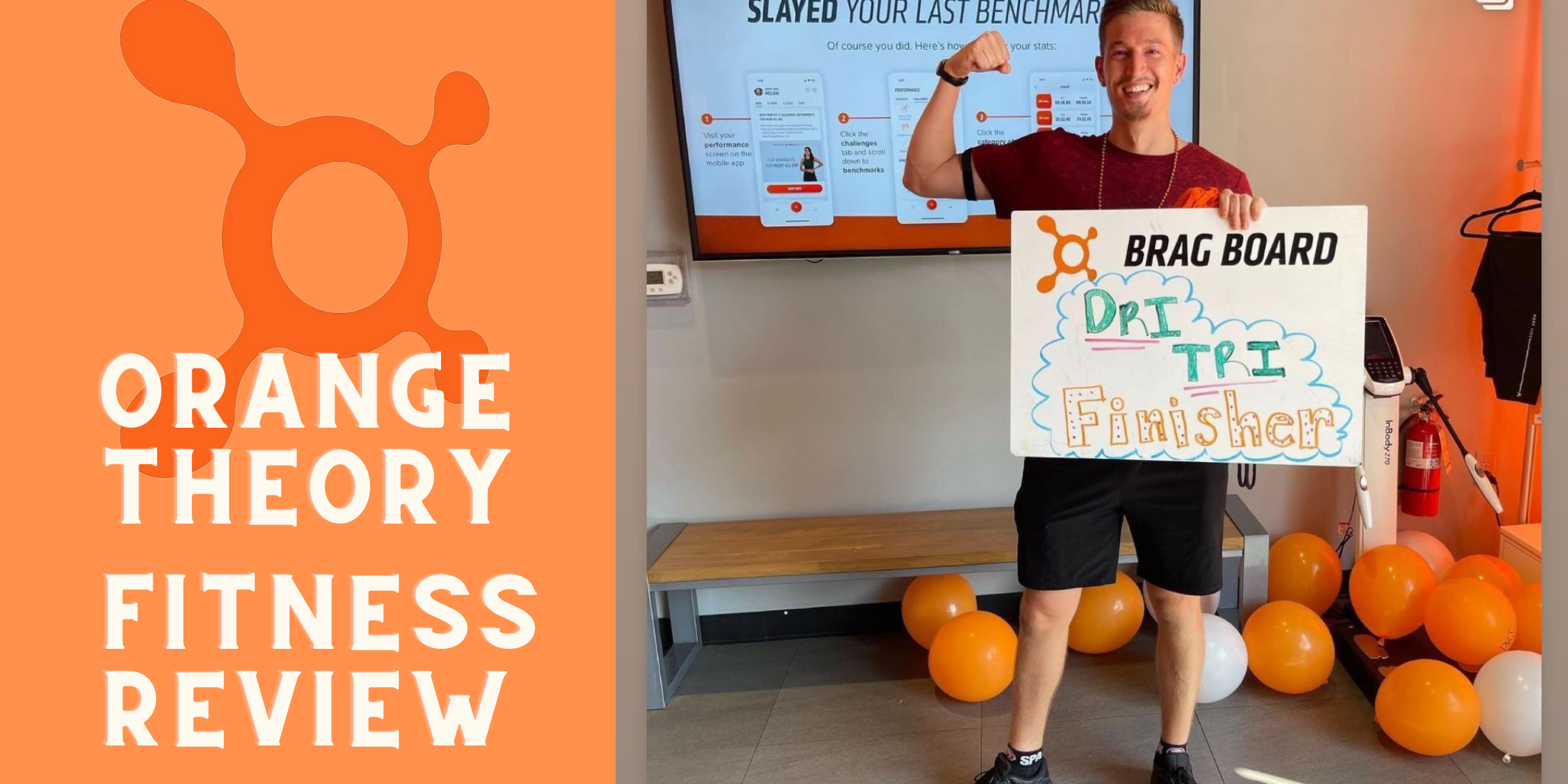In this post, I’ll be diving into Orangetheory Fitness to understand what the hype is all about!
Is it all hype? What is it exactly? Is it worth the money?
For Context:
I am an active member of Orangetheory Fitness and have done 160+ classes.
I have a good understanding of how it works and the benefits you can get as well.
Keep in mind, I would not recommend Orangetheory for every person because I think it’s best for specific types of goals which we’ll discuss later on.
After reading this full blog post, you’ll have a really good idea if Orangetheory is the right fit for you and your goals!
The Background
Orange Theory Fitness is an interval-style workout that combines cardiovascular exercises, strength training, and short bursts of high-intensity work.
This unique workout was created in 2007 by a physiologist named Ellen Latham.
She combined science and fitness in a really unique way and started a studio in the US to prove it.
After having major success with their Franchise model in the US, they started opening studios worldwide.
Now, they have studios in over 25 countries and it’s one of the most well-known fitness franchises out there.
The Concept
The overall concept is pretty simple, it’s a group-based class with a coach to guide you through the class and motivate you along the way
You are required to wear their “OTbeat” which measures your heart rate and performance data (speed, distance, intensity, etc.) in real-time and saves the data for you to review after the class as well.
Note: You will need to purchase the OTbeat if you decide to join their membership. The OTbeat costs around $130 one time.
All the information that is being tracked by the OTbeat is stored inside their OT app where you will see all your workouts, challenges, and upcoming classes.
Tracking your progress is an important part of Orangetheory because it is what allows you to accurately track your progress and keep you motivated and inspired to improve and push yourself to a great workout and hit new PRs.
During an Orangetheory class, with the use of the OTbeat, class-goers are connected to the tv screens, treadmill, and rower that monitors their heart rates and performance data throughout the class. This is seen by the person taking the class, as well as, the other class-goers and coach.
By keeping track of your heart rate, performance data, and the corresponding color categories (grey, blue, green, orange, and red) you reach different levels of intensity and can have different impacts on your workout.
Staying within the “orange zone” is a key part of the concept because it allows you to achieve optimal fat-burning benefits.
“The goal is to spend 12 minutes or more with your heart rate elevated in “The Orange Zone” to boost your metabolism, burn fat and burn more calories.” – OT Website
Another part of the concept is that all Orangetheory gyms around the world are all doing the same workout on the same day. So if it’s one of their Treadmill challenges that day, everyone who comes in that day, whether they’re in Australia or the United States, will be doing the same challenge.
This is one of my favorite parts about OT and what makes it fun and unique because you are no longer limited to competition within your local gym but also gyms around the world.
The social and community element is what a lot of people fall in love with.
The Workouts
Group-Style Classes with a Coach that is giving you instructions on what to do, when to do it, and how to do it.
Also, the coach is supporting you as you work out to ensure you’re doing the workout correctly, as well as, giving you the motivation to work harder.
3 Main types of workouts:
- Endurance
- Strength
- Power
Depending on the day, the main focus of the workout will change.
Some days it will be Endurance focused, other days it will be Strength and Power focused. They don’t tell you when you’ll have which, but generally, there is a pattern and even distribution throughout the week.
For example, I’ve noticed that Mondays tend to be endurance-focused.
You may find other patterns like this throughout the week but it’s not a guarantee!
This unknown can be beneficial for some class-goers who like to avoid certain types of workouts, which will ensure they get all 3 whether they feel like it or not.
Also, some days may have Strength focused but you’ll have parts that can be Endurance or Power focused as well.
If you become a regular goer (2-7 classes per week), you’ll be able to experience the benefits of all 3 types of workouts to give you a well-rounded workout structure.
3 Sections of Workouts:
- The Treadmill
- Includes a standard treadmill with a digital screen to sign in, and see your performance every step of the way.
- The Rower
- Includes a water rower and iPad to track your progress.
- The Floor (Strength Training)
- Dumbbells all the way up to 80 lbs
- A Bench
- Training Straps / Suspension Trainers
- Resistence bands
3 Types of Classes: 2G, 3G, and Lift 45
2G Class: This means that the class is divided into 2 parts/rotations, the first half is running on the treadmill and the second half is a mix of the floor and the rower.
On very rare occasions, the rower is not used or used very little during the second half.
3G Class: This means that the class is divided into 3 parts/rotations, where it’s evenly divided between the rower, the treadmill, and the floor.
Since it’s divided between 3, you will get less of the treadmill and the floor, but more of the rower compared to the 2G classes.
So if you’re in need of more treadmill or strength training, then definitely come on a 2G class day.
Lift 45: This means that the class is strength-training focused – no treadmills or rowing!
When you’re booking your class, you’ll be able to see if it’s a full body, upper body, or lower body focused class.
Also, the class is only 45 mins long, compared to the 60 mins long 2G and 3G classes.
The Challenges
Every month there are new challenges which can include Treadmills and Rowing, and every 6 months, there is something called DriTri which is all 3 in one.
Some Treadmill Challenges:
- 1 Mile – how fast you can run 1 mile
- Orange Everest – how far can you run with the incline scaling up from 2-15% and back down
- Marathon Month – where the goal is to accumulate as many miles as possible through the month
- And many more…
Some Rowing Challenges:
- 2000 Meter Row – regular row where speed is the goal
- Inferno – a mix of rowing and treadmill, but the goal is distance and speed on the rower
- 200 Meter Row – speed is the goal
- And many more…
DriTri Challenge:
- Triathlon of the 3 sections of workouts including a 2000 meter row, 300 reps on the floor and 5k on the treadmill.
- The goal is to get through it as fast as possible and your time is recorded and something you would want to improve over time.
- Want to learn more? Check out this Orangetheory DriTri Prep Blog Post
The Cost
How much does an Orangetheory OTbeat (Heart-Rate Monitor) cost?
It usually costs on average $125 but can vary based on taxes or location.
You need to purchase one before you start unless you want to rent it out for $5 per class.
How much does an Orangetheory Fitness membership cost?
Basic Plan – 4 Classes per Month: $69 / month ($17.25 per session)
Elite Plan – 8 Classes per Month: $119 / month ($14.87 per session)
Premier Plan – Unlimited Classes per Week: $169 / month ($8.45 per session @ 20 classes per month)
One Class (No Membership): $28 per Session
Class Packs:
- 10 Classes: $250 ($25 per session)
- 20 Classes: $450 ($22.50 per session)
- 30 Classes: $599 ($19.96 per session)
Costs can vary based on location and taxes.
For example, I am based in Brooklyn, New York and I was paying $198/month for Premier and now pay $135/month for Elite.
What fees does Orangetheory Fitness have?
If you pre-book a class and then cancel within 8 hours of the class, you will lose the class for that month. It used to be a $12 fee but now they just remove a class.
You can avoid this by showing up at the times you booked (follow through on your commitment) or not pre-booking if you have a bad habit of missing class.
The Results, Is It Worth It, and Who It’s For…
Okay, now that we know what Orangetheory is and how it works, let’s get to the most important questions!
What results can you get from it?
What types of goals will it support?
- Losing weight and getting leaner
- Finding a supportive community locally
- Reach new levels of fitness
- Hit new goals and PRs faster around running and rowing
- Improve your overall endurance, power, and strength
- Support you if you plan on doing Marathons, Spartan Races or Triathlons
- Having well-rounded workouts without you having to think about it, all you have to do is show up
What goals will it not support?
- If you have very specific weaknesses, muscles, or goals that you want to work on. It may not support you since the workouts are not specific to you.
- If you want to gain muscle or strength faster – you don’t get enough time on the Floor and can’t target specific muscles since it’s out of your control.
- If you want to gain weight – OT is not for you because you’ll be burning a lot of calories if you’re giving it 100% and going frequently.
- If you have a specific physique goal – you will get leaner but that doesn’t necessarily mean you’ll be happy with your physique since that requires intentional workouts toward specific body parts.
How it supported me?
From my experience of doing 160+ classes of Orangetheory, and doing months at 5-6x a week to months at 2x a week, I found that the results can vary of course.
In general, I found that I was able to be a lot leaner, lose body fat, increase my endurance and speed, and overall have more energy.
It has supported me greatly in being consistent and motivated with my cardio, while also slowly building muscle over time.
The coaches, community, and challenges keep me motivated to reach new levels of my fitness and hit new exciting goals.
Also, it has supported me in preparation for my Spartan Races, which I probably would of struggled with, not having Orangetheory.
Currently, I’m bulking and intentionally putting on more weight/muscle so I slowed down how many classes I’m taking in order to focus more on strength training with a structured program designed for me.
I still love doing Orangetheory to ensure I stay lean during this bulk, get a well-rounded workout in and continue to build my endurance for future Spartan races and Triathlons.
Is it worth the money?
I think that if you’re giving it 100% during your workouts, you’re doing the challenges, and engaging with the community, then it is definitely worth the money.
The more engaged you are, the more value you’ll get from it.
Also, at the end of the day, your progress still falls on your lap because it’s on you to set your goals, choose your weights, set your speeds and intensity, and continue to push your limits during your workouts.
If you choose to half-fast it or slack, week after week, then it’s likely just going to cost you a lot of money with little return.
What are your thoughts on Orangetheory Fitness? Drop a comment or question below!





![How Running Improves Your Overall Health [Physically, Mentally, and Emotionally]](https://funonfoot.com/wp-content/uploads/2023/01/How-Running-Improves-Your-Overall-Health-Physically-Mentally-and-Emotionally-110x80.png)



